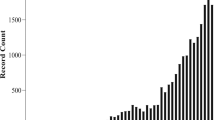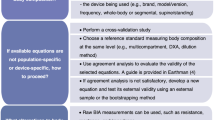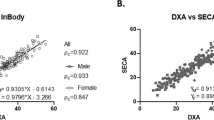Abstract
Background/Objectives:
Cross-validation of methods of body composition assessment necessitates statistical evaluation of the degree to which the two methods are in agreement. Typically, impedance-based methods for predicting body composition are assessed against other methods using limits of agreement and correlation analysis. Alternative approaches are presented with reference to example body composition data obtained using bioimpedance spectroscopy (BIS) and dual-energy X-ray absorptiometry (DXA).
Subjects/Methods:
A randomly selected data set, drawn from a body composition database, was analysed by limits of agreement analysis and error grid analysis.
Results:
The precision of BIS-derived predictions of percentage body fat relative to that of DXA can be determined from limits of agreement analysis. The importance of knowing the precision of the reference method in such analyses was highlighted. Error grid analysis has the potential to aid interpretation of method comparison data in an intuitively understandable way.
Conclusions:
Alternative ways of comparing analytical methods that are in use in other branches of biomedical research may prove useful when evaluating the utility of impedance-based methods and other methods for the assessment of body composition in cross-validation studies.
This is a preview of subscription content, access via your institution
Access options
Subscribe to this journal
Receive 12 print issues and online access
$259.00 per year
only $21.58 per issue
Buy this article
- Purchase on Springer Link
- Instant access to full article PDF
Prices may be subject to local taxes which are calculated during checkout


Similar content being viewed by others
References
Roche AF, Heymsfield SB, Lohman TG (eds) Human Body Composition 1st edn. Human Kinetics: Champaign, IL, 1996.
Duren DL, Sherwood RJ, Czerwinski SA, Lee M, Choh AC, Siervogel RM, Cameron Chumlea W . Body composition methods: comparisons and interpretation. J Diabetes Sci Technol 2008; 2: 1139–1146.
Lee SY, Gallagher D . Assessment methods in human body composition. Curr Opin Clin Nutr Metab Care 2008; 11: 566–572.
Jebb SA, Elia M . Techniques for the measurement of body composition: a practical guide. Int J Obes Relat Metab Disor 1993; 17: 611–621.
Bland JM, Altman DG . Statistical methods for assessing agreement between two methods of clinical measurement. Lancet 1986; 1: 307–310.
Fors H, Gelander L, Bjarnason R, Albertsson-Wikland K, Bosaeus I . Body composition, as assessed by bioelectrical impedance spectroscopy and dual-energy X-ray absorptiometry, in a healthy paediatric population. Acta Paediatr 2002; 91: 755–760.
Dehghan M, Merchant AT . Is bioelectrical impedance accurate for use in large epidemiological studies? Nutr J 2008; 7: 26–32.
Isenring E, Bauer J, Capra S, Davies PS . Evaluation of foot-to-foot bioelectrical impedance analysis for the prediction of total body water in oncology outpatients receiving radiotherapy. Eur J Clin Nutr 2004; 58: 46–51.
Critchley LA, Critchley JA . A meta-analysis of studies using bias and precision statistics to compare cardiac output measurement techniques. J Clin Monit Comput 1999; 15: 85–91.
Cecconi M, Rhodes A, Poloniecki J, Della Rocca G, Grounds RM . Bench-to-bedside review: the importance of the precision of the reference technique in method comparison studies--with specific reference to the measurement of cardiac output. Crit Care 2009; 13: 201–206.
Cornish BH, Thomas BJ, Ward LC . Improved prediction of extracellular and total body water using impedance loci generated by multiple frequency bioelectrical impedance analysis. Phys Med Biol 1993; 38: 337–346.
De Lorenzo A, Andreoli A, Matthie J, Withers P . Predicting body cell mass with bioimpedance by using theoretical methods: a technological review. J Appl Physiol 1997; 82: 1542–1558.
White GH, Farrance I . AACB Uncertainty of measurement working group. Uncertainty of measurement in quantitative medical testing. A laboratory implementation guide. Clin Biochem Rev 2004; 25: S1–S24.
Stover JF, Stocker R, Lenherr R, Neff TA, Cottini SR, Zoller B et al. Noninvasive cardiac output and blood pressure monitoring cannot replace an invasive monitoring system in critically ill patients. BMC Anesthesiol 2009; 9: 6–10.
van der Kleij SC, Koolen BB, Newhall DA, Gerritse BM, Rosseel PM, Rijpstra TA et al. Clinical evaluation of a new tracheal impedance cardiography method. Anaesthesia 2012; 67: 729–733.
Santos DA, Silva AM, Matias CN, Fields DA, Heymsfield SB, Sardinha LB . Accuracy of DXA in estimating body composition changes in elite athletes using a four compartment model as the reference method. Nutr Metab (Lond) 2010; 7: 22–30.
Scafoglieri A, Provyn S, Wallace J, Louis O, Tresignie J, Bautmans I, De Mey J, Clarys JP . Whole Body Composition by Hologic QDR 4500/A DXA: System Reliability versus User Accuracy and Precision. In: Ivanov (ed.). Applications and Experiences of Quality Control. Intechopen Publishing: NY, USA, 2012, pp 46–62.
Lohman TG . Dual energy X-ray Absorptiometry. In: Roche AF, Heymsfield SB, Lohman TG (eds). Human Body Composition, Human Kinetics: Champaign, IL, 1996 pp 63–78.
Parker L, Reilly JJ, Slater C, Wells JC, Pitsiladis Y . Validity of six field and laboratory methods for measurement of body composition in boys. Obes Res 2003; 11: 852–858.
Krouwer JS . Setting performance goals and evaluating total analytical error for diagnostic assays. Clin Chem 2002; 48: 919–927.
Krouwer JS, Cembrowski GS . A review of standards and statistics used to describe blood glucose monitor performance. J Diabetes Sci Technol 2010; 4: 75–83.
Clarke WL, Cox D, Gonder-Frederick LA, Carter W, Pohl SL . Evaluating clinical accuracy of systems for self-monitoring of blood glucose. Diabetes Care 1987; 10: 622–628.
Krouwer JS, Kallner A, Killeen A, Kondratovich M, Lindberg S, Nandagopalan S et al. How to Construct and Interpret an Error Grid for Diagnostic Assays; Proposed Guideline. Clinical Laboratory Standards Institute, Publication EP27-P: Wayne. PA, 2009, pp 58.
World Health Organisation. Physical status: the use and interpretation of anthropometry. Report of a WHO Expert Committee. WHO Technical Report Series 854. World Health Organization: Geneva, 1995.
Meeuwsen S, Horgan GW, Elia M . The relationship between BMI and percent body fat, measured by bioelectrical impedance, in a large adult sample is curvilinear and influenced by age and sex. Clin Nutr 2010; 29: 560–566.
Green DJ . Is body mass index really the best measure of obesity in individuals? J Am Coll Cardiol 2009; 53: 526.
Shah NR, Braverman ER . Measuring adiposity in patients: the utility of body mass index (BMI), percent body fat, and leptin. PLoS One 2012; 7: e33308.
Acknowledgements
We thank Dr Tim Essex for reading and providing valuable advice and critical comment on the manuscript. Publication of this article was supported by a grant from seca Gmbh & Co. KG, Hamburg, Germany.
Author information
Authors and Affiliations
Corresponding author
Ethics declarations
Competing interests
The authors declare no conflict of interest. Ward has consulted to ImpediMed Ltd. ImpediMed Ltd had no involvement in the conception and execution of this study or in the preparation of the manuscript.
Rights and permissions
About this article
Cite this article
Ward, L. Bioelectrical impedance validation studies: alternative approaches to their interpretation. Eur J Clin Nutr 67 (Suppl 1), S10–S13 (2013). https://doi.org/10.1038/ejcn.2012.159
Published:
Issue Date:
DOI: https://doi.org/10.1038/ejcn.2012.159
Keywords
This article is cited by
-
Ketogenic diets as treatment of obesity and type 2 diabetes mellitus
Reviews in Endocrine and Metabolic Disorders (2020)
-
Agreement Between Body Composition Assessed by Bioelectrical Impedance Analysis and Doubly Labeled Water in Obese Women Submitted to Bariatric Surgery
Obesity Surgery (2019)



